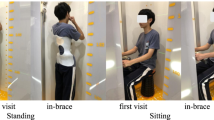Abstract
Purpose
Corrective three dimensional (3D) effect of different braces is debatable. We evaluated differences in in-brace radiographic correction comparing a custom thoracic-lumbo-sacral-orthosis (TLSO) (T) brace to a Chêneau type TLSO (C) brace using 3D EOS reconstruction technology. Our primary research question was the 3D effect of brace on the spine and in particularly the apical vertebra rotation (AVR).
Methods
This was a retrospective comparative analysis of patients with adolescent idiopathic scoliosis who had orthogonal AP and lateral X-rays with and without brace. A 3D image of the spine was reconstructed. Coronal, sagittal and axial spine parameters were measured before bracing and then on the first post-brace X-ray. Brace efficacy in controlling coronal, sagittal and axial parameters was evaluated.
Results
Eighteen patients treated with the C brace and ten patients treated with the T brace were included. No difference was found regarding patients’ age, gender, magnitude of Cobb angle, sagittal parameters or AVR at inclusion. Following bracing, AVR was significantly reduced by the C brace compared to the T brace [average correction of 8.2° vs. 4.9° (P = 0.02)]. Coronal and sagittal correction did not differ significantly between the two groups.
Conclusions
By utilizing a novel 3D reconstruction technology, we were able to demonstrate that braces differ in their immediate effects on the spine. Although clinical relevance should be evaluated in a future trial we feel that the ability to measure treatment effects in 3D, and especially the transverse plane, is an important tool when evaluating different treatments.
Similar content being viewed by others
References
Richards BS, Bernstein RM, D’Amato CR, Thompson GH (2005) Standardization of criteria for adolescent idiopathic scoliosis brace studies: SRS committee on bracing and nonoperative management. Spine (Phila Pa 1976) 30(18):2068–2075
Humbert L, De Guise JA, Aubert B, Godbout B, Skalli W (2009) 3D reconstruction of the spine from biplanar X-rays using parametric models based on transversal and longitudinal inferences. Med Eng Phys 31(6):681–687
Pomero V, Mitton D, Laporte S, de Guise JA, Skalli W (2004) Fast accurate stereoradiographic 3D-reconstruction of the spine using a combined geometric and statistic model. Clin Biomech (Bristol, Avon) 19(3):240–247
Dubousset J, Charpak G, Skalli W, Kalifa G, Lazennec JY (2007) EOS stereo-radiography system: whole-body simultaneous anteroposterior and lateral radiographs with very low radiation dose. Rev Chir Orthop Reparatrice Appar Mot 93(6 Suppl):141–143
Kalifa G, Charpak Y, Maccia C, Fery-Lemonnier E, Bloch J, Boussard JM, Attal M, Dubousset J, Adamsbaum C (1998) Evaluation of a new low-dose digital X-ray device: first dosimetric and clinical results in children. Pediatr Radiol 28(7):557–561
Labelle H, Aubin CE, Jackson R, Lenke L, Newton P, Parent S (2011) Seeing the spine in 3D: how will it change what we do? J Pediatr Orthop 31(1 Suppl):S37–S45
Labelle H, Dansereau J, Bellefleur C, Poitras B (1996) Three-dimensional effect of the Boston brace on the thoracic spine and rib cage. Spine (Phila Pa 1976) 21(1):59–64
Rigo M, Weiss HR (2008) The Chêneau concept of bracing—biomechanical aspects. Stud Health Technol Inform 135:303–319
Clin J, Aubin CE, Parent S, Sangole A, Labelle H (2010) Comparison of the biomechanical 3D efficiency of different brace designs for the treatment of scoliosis using a finite element model. Eur Spine J 19(7):1169–1178
Clin J, Aubin CÉ, Sangole A, Labelle H, Parent S (2010) Correlation between immediate in-brace correction and biomechanical effectiveness of brace treatment in adolescent idiopathic scoliosis. Spine (Phila Pa 1976) 35(18):1706–1713
Aubin CE, Dansereau J, de Guise JA, Labelle H (1997) Rib cage-spine coupling patterns involved in brace treatment of adolescent idiopathic scoliosis. Spine (Phila Pa 1976) 22(6):629–635
Ilharreborde B, Steffen JS, Nectoux E, Vital JM, Mazda K, Skalli W, Obeid I (2011) Angle measurement reproducibility using EOS three-dimensional reconstructions in adolescent idiopathic scoliosis treated by posterior instrumentation. Spine (Phila Pa 1976) 36(20):E1306–E1313
Glaser DA, Doan J, Newton PO (2012) Comparison of 3D spinal reconstruction accuracy: biplanar radiographs with EOS versus computed tomography. Spine (Phila Pa 1976) 37(16):1391–1397
Conflict of interest
None.
Author information
Authors and Affiliations
Corresponding author
Rights and permissions
About this article
Cite this article
Lebel, D.E., Al-Aubaidi, Z., Shin, EJ. et al. Three dimensional analysis of brace biomechanical efficacy for patients with AIS. Eur Spine J 22, 2445–2448 (2013). https://doi.org/10.1007/s00586-013-2921-3
Received:
Revised:
Accepted:
Published:
Issue Date:
DOI: https://doi.org/10.1007/s00586-013-2921-3




